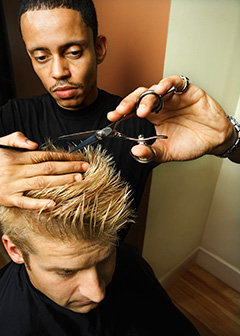Summary
Please enable javascript to play this video.
| Quick Facts: Barbers, Hairstylists, and Cosmetologists | |
|---|---|
|
$35,420 per year
$17.03 per hour |
|
| Postsecondary nondegree award | |
| None | |
| None | |
| 651,200 | |
| 5% (Faster than average) | |
| 35,300 | |
What Barbers, Hairstylists, and Cosmetologists Do
Barbers, hairstylists, and cosmetologists provide haircutting, hairstyling, and other services related to personal appearance.
Work Environment
Barbers, hairstylists, and cosmetologists work mostly in barbershops or salons. Most are full time, although part-time work is common. Work schedules may vary and often include evenings and weekends.
How to Become a Barber, Hairstylist, or Cosmetologist
All states require barbers, hairstylists, and cosmetologists to be licensed. To qualify for a license, candidates typically must graduate from a state-approved barber or cosmetology program and pass an exam.
Pay
The median hourly wage for barbers was $18.73 in May 2024.
The median hourly wage for hairdressers, hairstylists, and cosmetologists was $16.95 in May 2024.
Job Outlook
Overall employment of barbers, hairstylists, and cosmetologists is projected to grow 5 percent from 2024 to 2034, faster than the average for all occupations.
About 84,200 openings for barbers, hairstylists, and cosmetologists are projected each year, on average, over the decade. Many of those openings are expected to result from the need to replace workers who transfer to different occupations or exit the labor force, such as to retire.
State & Area Data
Explore resources for employment and wages by state and area for barbers, hairstylists, and cosmetologists.
Similar Occupations
Compare the job duties, education, job growth, and pay of barbers, hairstylists, and cosmetologists with similar occupations.
More Information, Including Links to O*NET
Learn more about barbers, hairstylists, and cosmetologists by visiting additional resources, including O*NET, a source on key characteristics of workers and occupations.
 United States Department of Labor
United States Department of Labor




